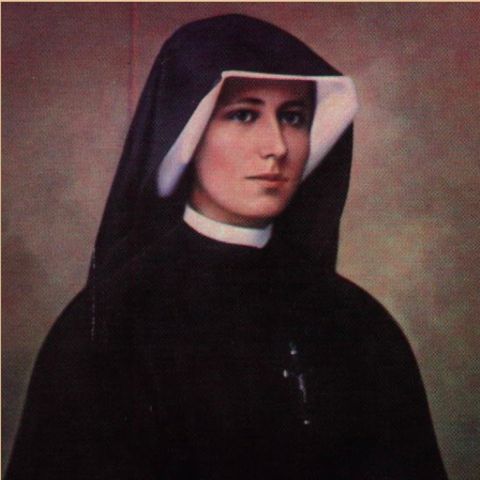October 5: Saint Faustina Kowalska, Virgin

Sign up for free
Listen to this episode and many more. Enjoy the best podcasts on Spreaker!
Download and listen anywhere
Download your favorite episodes and enjoy them, wherever you are! Sign up or log in now to access offline listening.
Description
October 5: Saint Faustina Kowalska, Virgin 1905-1938 Optional Memorial: Liturgical Color: White Patron Saint of Mercy Her humble sail caught a powerful theological wind The martyr Saint Faustino was killed...
show more1905-1938
Optional Memorial: Liturgical Color: White
Patron Saint of Mercy
Her humble sail caught a powerful theological wind
The martyr Saint Faustino was killed in the second decade of the second century in northern Italy under the emperor Hadrian. Nothing else is known of him. Today’s saint was baptized Helen and, for unknown reasons, was given the martyr’s name when making her first religious vows. Saint Faustino must be honored, and grateful, to share his name with so holy and consequential a nun as Saint Maria Faustina Kowalska, who was canonized in 2000, and whose optional memorial was added to the Church’s universal calendar in 2020.
Saint Faustina was a peasant in the best sense of the word. She could read and write but otherwise attended school for only a few years in her rural village in central Poland. Her large and pious family needed her hand on the plow, financially speaking, and so at the age of sixteen young Helen Kowalska obtained work as a housekeeper in nearby towns. She was expert in the domestic arts of sewing, cleaning, cooking, and the related skills which convert a house into a home. These skills served her well, but not long, in the convents where she resided throughout her short life.
While she felt called to be a religious sister as a child, Helen’s parents were reluctant to let her enter a convent at too tender an age. But then, in her late teens, Christ appeared and spoke to Helen in mysterious and deeply personal encounters, demanding that she not keep Him waiting much longer. These visions propelled the pious teen to seek acceptance in a big-city convent. She moved to Warsaw at nineteen, received advice from a sympathetic priest, and knocked on the doors of various convents hoping that one of them, just one, would accept her. One finally did. After proving herself in its novitiate, she took solemn vows and spent the rest of her life as a faithful nun doing humble chores alongside her religious sisters in convents in Poland and present-day Lithuania.
Like so many saints, the unseen vigils, prayers, mortifications, fasts, and sufferings were Faustina’s real life, while the visible realities seen by her fellow religious and the occasional visitor were of lesser importance. And what went unseen in Saint Faustina’s life was astounding! This humble nun experienced remarkably vivid, high-octane, technicolor, 3-D visions of Jesus Christ in the chapel, behind the door, in her cell, and around every corner for many years. Jesus’ strong voice spoke to her in a direct and unmistakably clear manner about His desires for her life. He commanded her, repeatedly, to spread the message of Divine Mercy. So Faustina had an artist paint a famous image of Christ with two rays emanating from his chest, promoted a liturgical feast day in honor of the Divine Mercy on the Sunday after Easter, and kept an exhaustive diary chronicling the content of her vivid spiritual experiences.
Saint Faustina’s message is not really Saint Faustina’s message. It is God’s message. God wants mankind to know, and to feel, the Divine Mercy oozing out of the heart of Christ. This mercy, unlike human or judicial mercy, can wash away even the most wretched sins. God’s mercy is not in competition with his justice but is an over abundance of justice. God knows all things and forgives all things when His mercy is freely requested. The modern western world is very focused on questions of justice – racial justice, economic justice, environmental justice, etc… But it is, at the same time, opposed to judging. This dichotomy of favoring justice but abhorring judging is incongruous. The modern west suffers from similar tensions regarding the virtue of mercy.
An American Cardinal noted years ago that modern secular culture permits, even promotes, practically everything. It seems that no moral aberration, sin, or dysfunctional behavior is not smiled upon as a rightful expression of personal freedom. And yet…modern secular culture forgives almost nothing. “Just Do it!” But, beware, when you do do it, you might never be forgiven for having done it. The message of Divine Mercy is that because all can be forgiven, all relationships can be restored. Relationships precede our rights and even our choices. We are more than our choices! We are more than our rights! And when we receive mercy, or extend mercy to others, our relationships with ourselves, with friends, family, nature, and God are restored.
Every expression or reception of mercy is like a mini jubilee-year. Every traveler returns home, every field lies fallow, and every debt is forgiven. Mercy is the father waiting on the ridge. He sees the ragged figure on the horizon limping home in the evening light. The petition for mercy. The granting of mercy. The tight embrace. The relationship restored. The ring on his finger. The robe on his back. The calf on the spit. The feast begins. Divine Mercy conquers all.
Saint Faustina, your humble and generous service to the Church included sharing your visions and the message of Divine Mercy. Help all who seek your intercession to be blessed with your same virtue and your same docility to God’s will.
Information
| Author | Fr. Michael Black |
| Organization | Michael Black |
| Website | - |
| Tags |
Copyright 2024 - Spreaker Inc. an iHeartMedia Company
